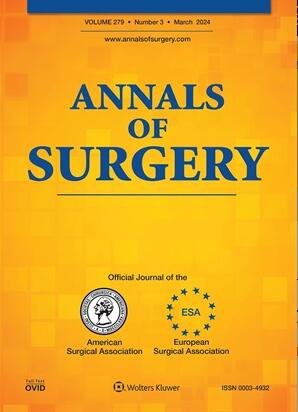Anticoagulation Practice and Risk of Portal Vein Thrombosis Following Pancreaticoduodenectomy or Total Pancreatectomy with Venous Resection: An International Multicentre Cohort Study.
IF 6.4
1区 医学
Q1 SURGERY
引用次数: 0
Abstract
OBJECTIVE Assess anticoagulation practice and portal vein thrombosis (PVT) risk following pancreaticoduodenectomy (PD) or total pancreatectomy (TP) with venous resection (VR). BACKGROUND Retrospective studies suggest an increased risk of PVT following PD/TP with VR. However, anticoagulation practice is variable and its efficacy at preventing PVT is unknown. METHODS This multicentre cohort study (Europe, USA, Mexico, Turkey, Australia, New Zealand) included consecutive patients undergoing PD/TP with VR between 2018-2022. A 1:1 age and sex matched cohort undergoing PD/TP without VR was also collected to assess PVT risk without VR. RESULTS Among 972 patients who underwent PD/TP with VR, 259 (26.6%) received inpatient therapeutic anticoagulation and 242 (25.0%) were discharged on therapeutic anticoagulation. Thirty-day, 90-day and one-year PVT risk following VR was 5.1%, 7.3%, and 11.6%, versus 1.0%, 1.3% and 2.6% in patients without VR (P<0.001). Predictors of 90-day PVT included prior history of venous thromboembolism (odds ratio [OR] 2.67), VR type (OR 2.29, 6.28, 6.90 and 23.75 for type 1-4 VR, P<0.001) and graft material (OR 0.78, 0.94, 5.28, 4.90 and 5.99 for peritoneal, autologous vein, cadaveric vein, bovine and synthetic grafts, P<0.001). Postoperative therapeutic anticoagulation reduced 30-day PVT risk (OR 0.06, P<0.001), but not 90-day (OR 0.06, P=0.075) or >90-day PVT risk (OR 1.23, P=0.466). The strongest predictor of >90-day PVT was cancer recurrence (OR 3.96, P<0.001). CONCLUSIONS VR increases PVT risk following PD/TP, with technical factors influencing <90-day PVT and cancer-related factors influencing >90-day PVT. The benefits of early postoperative anticoagulation in preventing PVT post-VR remain unclear.一项国际多中心队列研究:胰十二指肠切除术或全胰切除术合并静脉切除术后门静脉血栓形成的风险和抗凝措施。
目的评估胰十二指肠切除术(PD)或全胰切除术(TP)合并静脉切除术(VR)后的抗凝措施和门静脉血栓形成(PVT)风险。背景:回顾性研究表明PD/TP合并VR后PVT的风险增加。然而,抗凝实践是可变的,其在预防PVT的功效是未知的。方法这项多中心队列研究(欧洲、美国、墨西哥、土耳其、澳大利亚、新西兰)纳入了2018-2022年间连续接受PD/TP合并VR的患者。还收集了一个1:1年龄和性别匹配的无VR的PD/TP队列,以评估无VR的PVT风险。结果972例PD/TP合并VR患者中259例(26.6%)接受住院治疗性抗凝治疗,242例(25.0%)出院治疗性抗凝治疗。VR后30天、90天和1年PVT风险分别为5.1%、7.3%和11.6%,而无VR患者的p90天PVT风险分别为1.0%、1.3%和2.6% (OR 1.23, P=0.466)。bbbb90天PVT的最强预测因子是癌症复发(OR 3.96, p90天PVT)。术后早期抗凝在预防vr后PVT中的益处尚不清楚。
本文章由计算机程序翻译,如有差异,请以英文原文为准。
求助全文
约1分钟内获得全文
求助全文
来源期刊

Annals of surgery
医学-外科
CiteScore
14.40
自引率
4.40%
发文量
687
审稿时长
4 months
期刊介绍:
The Annals of Surgery is a renowned surgery journal, recognized globally for its extensive scholarly references. It serves as a valuable resource for the international medical community by disseminating knowledge regarding important developments in surgical science and practice. Surgeons regularly turn to the Annals of Surgery to stay updated on innovative practices and techniques. The journal also offers special editorial features such as "Advances in Surgical Technique," offering timely coverage of ongoing clinical issues. Additionally, the journal publishes monthly review articles that address the latest concerns in surgical practice.
 求助内容:
求助内容: 应助结果提醒方式:
应助结果提醒方式:


